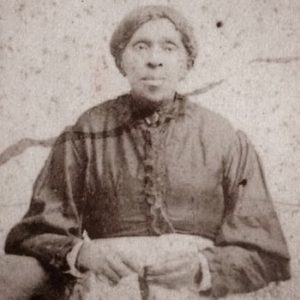
Harriet Powers
Harriet Powers was born on this date in 1837. She was a Black artist who worked in textile needlework.
Born a slave in Athens, GA, she married Armstead Powers; her first daughter Amanda was born when she was 18. In time, eight more children were born to Harriet and Armstead; the last son, Marshall, census records suggest, was born in 1872. Some historians speculate she spent her early years on a plantation owned by John and Nancy Lester northeast of Athens near Danielsville in Madison County. Powers learned the art of quilt-making embroidered with appliqué work from her plantation mistress or other slaves.
Blacks did fancy needlework for their owners during the daylight hours and labored to provide practical clothing and bed covers for their families by candlelight. Textile historians also note significant similarities between Powers' work and the technique mastered by the Fon people of Dahomey, West Africa. Immediately following the close of the American Civil War in April 1865, life was extremely difficult for both the white and Black populations in Clarke County. Armstead Powers identified himself as a "farmhand" in the 1870 census; Harriet is listed as "keeping house"; their three children, Amanda, Leon Joe (Alonzo), and Nancy, lived at home.
That year, records show that the family-owned no land in Clarke County but claimed $300 in personal property. The Powers family lived in the Buck Branch District of Clarke County by 1873 but alternated between the Buck Branch and Sandy Creek districts of Clarke County beginning in 1870. By the 1880s, they had four acres of land of their own. In the 1890s, however, Armstead and Harriet Powers' short-lived prosperity dwindled. Armstead sold off parcels of land, eventually defaulted on taxes, and, after 1894, left Harriet and the farm.
Harriet never remarried but remained independent in her home at Sandy Creek, supporting herself as a seamstress. Powers exhibited her first story quilt at a Cotton Fair in Athens in 1886. The appliqué quilt depicted scenes from Bible stories and spirituals she committed to memory and was made of 299 pieces of fabric machine-stitched to a background of watermelon color cotton. Her work caught the eye of Oneida Virginia ("Jennie") Smith, then head of the art department at the Lucy Cobb Institute. She offered to buy it, but Powers refused to sell it at any price. After four years of unsuccessful negotiation between the two women, 1891, Powers approached Jennie again and offered the Bible quilt for sale. She took the five dollars and left for home.
Fortunately for posterity, she also left Jennie Smith a detailed oral description of each of the quilt's 11 panels. Smith entered Harriet Powers' Bible Quilt at Atlanta's 1895 Cotton States and International Exposition. The faculty women at Atlanta University commissioned a second narrative quilt from Harriet Powers to be a gift in 1898 to the Reverend Charles Cuthbert Hall, president of the Union Theological Seminary and longtime chairman of the board of trustees of Atlanta University. The 15 panels of Powers' second story quilt illustrated Biblical or verifiable astronomical events.
She stitched into the quilt scenes inspired by Bible stories, her recollection of events that occurred during her lifetime, and even her depiction of unusual natural events she heard about that occurred before her birth. For example, one panel illustrates the "dark day" of May 19, 1780 (now identified as dense smoke over North America caused by Canadian wildfires) and November 13, 1833, as the "night of falling stars" that convinced many terrified Americans that Judgment Day had come but was later identified as the Leonid meteor storm.
Composed of a needle and scraps of fabric instead of a pen and paper, the narrative or story quilts stitched by this self-effacing black woman survived a remarkable journey from cabins on Clarke County's back roads to places of honor in major American museums. Powers’ first Bible quilt is now part of the Smithsonian Institution's collection in Washington, D.C. In contrast, her second narrative quilt, held by the Museum of Fine Arts in Boston, was a centerpiece of a major exhibition of American Folk Art there in the summer of 2001. Harriet Powers died in 1911.
To be an Artist
To become a jeweler, seamstress, or textile/fine artist.
The African American Desk Reference
Schomburg Center for Research in Black Culture
Copyright 1999 The Stonesong Press Inc. and
The New York Public Library, John Wiley & Sons, Inc. Pub.
ISBN 0-471-23924-0